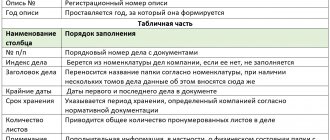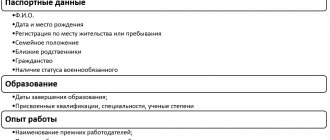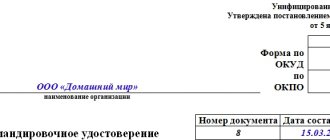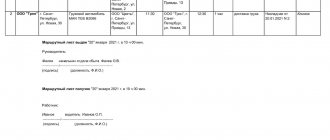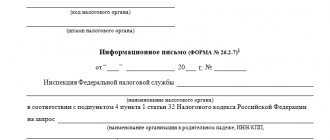An employee’s personal file is all his documents, collected in one place, and which relate to his work in a given organization or with a given individual entrepreneur (IP). An authorized employee of an organization or individual entrepreneur, for example, a personnel officer or accountant, must fill out an employee’s personal file if the organization or individual entrepreneur does not have a personnel department. A personal file is opened for an employee when he is hired. The task of the HR employee is not only to prepare documents for employees and store them, but also to protect the personal data of employees . Agreements must be signed with absolutely all employees that employees give permission to collect, store, and process their personal information. This agreement is also kept in your personal file. If there is no such permission, the organization or individual entrepreneur will be fined a large sum of money.
What documents are included in an employee’s personal file?
A complete list of documents that must be kept in an employee’s personal file exists only in government agencies. For commercial organizations or individual entrepreneurs that have employees, there is no such list, but they can take advantage of the requirements for government agencies in terms of personal files of employees. A personal file consists of a whole list of various documents. The recommended list of documents is as follows.
| p/p | Name |
| 1 | description of personal file |
| 2 | employee personal card |
| 3 | employee profiles |
| 4 | application for a job |
| 5 | employee resignation letter |
| 6 | employment contract and additional agreements thereto |
| 7 | the following types of orders: · The order of acceptance to work; · dismissal order; · order on incentives; · collection order; · transfer order; · other orders |
| 8 | reports and explanatory notes of the employee himself, as well as reports and explanatory notes in relation to this employee |
| 9 | copies of documents on the basis of which changes are made to personal data, the storage of which is permitted by law |
| 10 | work books |
| 11 | medical records, certificates of completed medical examination |
| 12 | characteristics, letters of recommendation from the employee’s previous places of work |
| 13 | various certificates, for example, certificates from previous places of work, certificates of no criminal record, etc. |
| 14 | copies of diplomas, certificates, certifications, advanced training, etc., if the availability of these documents is mandatory for occupying the corresponding position |
| 15 | autobiographies |
| 16 | copies of documents confirming disability or the degree of limitation of ability to work, if permitted by law |
| 17 | copies of documents permitting access to information constituting a state or other secret protected by law, if the presence of these documents is mandatory for occupying the corresponding position |
The following documents may also be stored in the employee’s personal file:
- employee job description;
- agreement on liability;
- non-disclosure agreement of trade secrets;
- employee consent to work with personalized data;
- other similar documents
Preparing files for archival storage
A certain preparation of cases for transfer to archival storage is required, which consists of combining disparate documents into a single file. The volume of the folder containing the archive file should not exceed 250 pages. When designing one folder, you need to:
- sew (4 punctures) or bind all pages;
- number the pages in the upper right corner;
- draw up an internal inventory of documents - table of contents;
- prepare a certification sheet (mark the number of pages, compliance with numbering, etc.; certified by the signature of the compiler);
Sample filling and form of certification sheet
- make a hard cardboard cover for each case (with the name of the organization, title, last dates, registration number of the “Case” folder);
Sample cover design for the “Case” folder
What does an employee’s personal file consist of?
The personal file form is developed and approved by the organization itself or the individual entrepreneur personally . An organization or an individual entrepreneur may develop a local regulatory act, for example, a regulation on the management of personal affairs of employees. In this provision, you can describe everything related to the management of personal affairs, for example, what documents employees are required to provide to an organization or individual entrepreneur upon employment, what documents are drawn up by the organization or individual entrepreneur itself, as well as other issues on this topic. This local regulatory act is approved by order signed by the director. When forming this local regulatory act, you can be guided by the following legislative acts:
- chapters 10,11,12,13,14 of the Labor Code of the Russian Federation;
- Federal Law No. 152 of July 27, 2006 “On Personal Data”;
- “Basic Rules for the Operation of Organizational Archives” (approved by the decision of the Board of Rosarkhiv dated 02/06/02);
- Federal Law No. 125 of October 22, 2004 “On Archival Affairs in the Russian Federation”;
- Order of the Ministry of Culture of the Russian Federation No. 558 dated August 25, 2010 “On approval of the List of standard management archival documents generated in the course of the activities of state bodies, local governments and organizations, indicating storage periods”;
- Federal Law No. 79 of July 27, 2004;
- Federal Law No. 25 of 03/02/07;
- Decree of the President of the Russian Federation No. 640 of 01.06.98;
- Decree of the President of the Russian Federation No. 609 of May 30, 2005;
- other regulations
The formation of a personal file can be roughly divided into stages:
- filling out the title page;
- preparation of a certification sheet;
- filling out the internal inventory;
- file file
It is not recommended to create personal files longer than 250 pages. Personal files are usually stored in alphabetical order by divisions or branches of the organization, if any.
It is also very convenient to keep a log of employees' personal files. The log should contain the following information:
- employee personal file numbers;
- last names, first names, patronymics of employees;
- dates of transfer of personal files to the archive;
- dates of commencement of personal affairs;
- other necessary information
If an employee has any changes in his personal data, for example, his last name has changed, then he must notify the personnel service about this and provide documents confirming these changes.
Registration procedure
Since in any enterprise, due to the large number of employees, it is impossible to keep track of all documents and their flow, it is very important to follow all the rules of registration in order to avoid the loss of important information that may interfere with the organization of the work process.
Proper storage and registration of personal files of all employees greatly simplifies the task:
- For example, if the company is large enough and employs a large number of employees, their personal files should be placed in alphabetical order. This will make it easier to find the desired folder.
- The employee’s personal file should not contain more than 250 pages.
- The cover page should display only basic information about the personal file. This is your full name. employee and case number at the enterprise.
Personal files can be stored in the following ways:
- In alphabet order.
- By structural divisions of the company (departments).
- Numbering of cases by their numbers or assignment of numbers during registration.
How to fill out an employee's personal file
Typically, a cover page provides as much information as possible about the employee in order to make it easier to find the required information. The cover page of a personal file may look like this.
| Title page section title | How to fill out |
| Name of the organization | The name of the organization is indicated; if the organization has divisions or branches, then the name of the division or branch in which the employee works is indicated |
| Serial number | In order to avoid confusion in personnel work, it is necessary to number personal files |
| Full name of the employee | Simplifies the search for an employee’s personal file by HR or accounting department employees |
| Date of opening of personal file | The date of opening a personal file usually coincides with the date of the employment order |
| Date of closing of personal file | The date of closure of the personal file must coincide with the date of the order to dismiss the employee |
| Number of sheets in personal file | This information is filled out before submitting documents to the archives. |
A certification sheet is needed to note the numbering of documents in the file, the physical condition of the sheets, the specifics of filling out individual forms, etc. The certification sheet states:
- letter numbers of sheets;
- envelopes with attached attachments in them;
- damaged sheets;
- sheets with photographs;
- missing pagination
The internal inventory consists of the following sections.
| Title of the title section of the internal inventory | How to fill out |
| Personal document number | The number is indicated here in order |
| Full name of the employee | The employee's last name, first name and patronymic must be indicated. |
| Serial number | The serial number of the entry in the inventory is indicated |
| Document index | The document index is indicated if available |
| Document title, summary | This section indicates which document is included in the inventory; for example, the entry may look like “Job Application” |
| Case sheet numbers | This indicates under what numbers the specified documents are stored in the personal file. |
| Date of inclusion of the document in the personal file | The date when the document was included in the personal file is indicated |
| Note | Section for any additional information |
| Number of documents in words | At the end of the inventory, the number of documents contained in this inventory is indicated in numbers and in words. |
| Number of internal inventory sheets | The number of pages in the inventory is indicated here |
| Responsible officer | The signature of the authorized employee, the transcript of the signature, the date are affixed |
Sample
As stated above, only authorized employees have access to make changes to personal files.
The heading for the personal file is your full name. employee. Variations in the spelling of the surname or the woman's maiden name may also be indicated. For example: Bread (Kalinina) Elena Maksimovna.
When registering a personal file, it is allowed to accept documents that are dated earlier than the date the employee was hired. This issue is considered in individual cases, but, as a rule, it is resolved in favor of the employee.
The complete case form includes the following items:
- Design and entry of data on the cover of the folder (cover design will be discussed later).
- It is important to record the number of sheets in the case (no more than 250 pages).
- Preparation of the certification sheet.
- Internal inventory of documents in accordance with the apparent quantity collected, data verification.
- File filing, case binding.
- Entering the necessary information into the cover of the employee’s personal file.
It is very important to know which documents are filed and which are not. The case file includes only the most important and significant documents, which can be stored for up to 75 years. If there are documents about the beginning of vacation, applications for vacation at your own expense, and the like, then these documents are not included in the filing folder. They are added to the total quantity.
Storage periods for personal files
Since the personal files of employees contain confidential information in the form of personal data of employees, personal files must be stored in safes or a special cabinet, which must be locked with a key. Only authorized employees may have access to such information. Such employees are approved by order of the organization or individual entrepreneur signed by the director. If an employee quits, his personal file can be kept in the organization for 3 years after that. After this period, his personal file is transferred to the archive and stored there. All personal files that are not used in work are stored in the archive. If a personal file was created after 2003, then its storage period is 50 years, and if before 2003, then 75 years, and the personal files of senior employees are stored indefinitely. The retention period begins to count from the moment the file is transferred to the archive. If a personal file includes documents with different retention periods, then the entire personal file is stored for the maximum period.
Personal files can be stored, for example:
- by serial numbers;
- by last name, first name, patronymic of employees (alphabetically);
- by personnel numbers of employees;
- by branches, divisions;
- by dates of opening of personal files;
- in other ways
Where are they used?
The formation, maintenance and storage of personal files of employees is used in all labor spheres:
- At enterprises and organizations. Municipal and federal laws impose responsibilities on specialists for maintaining appropriate folders for each employee and employee.
- In companies operating privately. The Labor Code does not prescribe the obligations of private companies to maintain labor records, but such an order can be determined by higher organizations or company owners.
How to fill out an employee application form
In many organizations or individual entrepreneurs, during interviews, employees are asked to fill out a questionnaire. The questionnaire is designed to give employers an idea of the employee’s qualifications, education, work experience, etc. The application form is usually accompanied by a photograph of the employee. The questionnaire usually contains the following questions:
- about education;
- about human interests;
- about work experience;
- about previous places of work;
- about marital status;
- about the presence or absence of children;
- questions about a person’s gender and age;
- about bad habits;
- about the absence of any diseases (for certain types of work);
- about qualifications;
- about professional skills;
- about professional achievements;
- other information
Rules for storing archival documents
Archives for storing “Case” folders are located in separate rooms that guarantee the safety of stored documentation. The premises must be dry, heated, well ventilated, and comply with fire safety and sanitary standards. Thus, the archival service guarantees the protection of stored “Case” folders from damage.
In addition, the archive must be securely protected (with the help of metal bars on the windows, security alarms, etc.), and then the “Case” folders will not be damaged by strangers or stolen.
All “Case” folders are placed on special numbered shelves; long-term storage is in boxes or cases; less valuable ones (up to 10 years) can be placed in bundles. It is prohibited to place individual “Case” folders on the floor or window sills.
If the volume of “Case” folders is very large, archive staff can draw up so-called topographic maps that will help navigate among the shelves and racks
Special opinion
An organization's documents are a valuable resource of information. To prevent it from being used against you, you should adhere to the rules for storing documentation that are prescribed by law. But the legislative system determines the procedure for creating an archive. Each enterprise decides independently which method of document storage to choose and how to arrange documents in the archive.
There are two main approaches to document storage: creating an archive at the enterprise on your own and transferring documents for storage to archival companies.
To organize your archive yourself, you will need:
- Competent personnel with the knowledge and experience to carry out archival processing of documentation and transfer cases to the archive (drawing up inventories, drawing up acts on the allocation of documents for destruction, etc.).
- A specialized room for long-term storage of paper information media, where the requirements for humidity, temperature and amount of light are met.
When the company's document flow is small, all documents can be stored in the same room where the work process takes place. If there is a lot of documentation, it is necessary to allocate a separate room for the archive.
To make it easy to find any document in the archive you organize, create a nomenclature of files - a classifier of documentation indicating their storage periods.
You can simplify the search for the necessary documents by using the following tips:
- allocate each structural unit its own place for documentation, taking into account annual replenishment;
- distribute on different shelves items that have a permanent shelf life and a temporary one (more than 10 years).
Keep personnel files and documentation of liquidated companies (if any) separately.
Outsourcing document storage has certain advantages over self-storage and is suitable for those who plan to:
- Save money by reducing the cost of renting and maintaining office space used for storage.
- Increase the efficiency of employees and reduce non-core workload, which often falls on the shoulders of employees in the accounting and human resources departments.
- Ensure continuity of processes in document management.
- Create an electronic archive that allows you to quickly access the documentation database at any time and optimize the time for searching it.
Choose your storage partner carefully.
Hello and have a nice day!
Many, many letters and photos under the cut....
I live with my husband, so we keep the documents together. There are more than 5 countries of residence and nationalities between the two of us, so the number of documents naturally increases because of this.
Common storage methods
1. Firstly, I store all documents in this way:
The folder contains a bunch of transparent files, divided into categories with colored separators. Each file contains the ORIGINAL + several copies (because copies are very often needed, not everyone has a copy machine at home, and they don’t always have time if they need something urgently). This way we never have problems with copies and where to look for the original.
When you need to go somewhere, we just take the corresponding folder with us (since very often you don’t know what other piece of paper they’ll ask you for), otherwise everything is in one place + there are copies and you don’t have to run around if anything happens.
2. Secondly, within each category, documents are divided according to the principle “what you received first is the first,” that is, first the birth certificate, then the passport, then someday there will be a pension, etc., etc.
3. Thirdly, we have our photos in the folder with documents, otherwise very often we need photos, but we don’t have the time or desire to run somewhere to take them. Well, it’s okay that I changed my hair color :))
4. Fourthly, all of our documents have already been scanned and stored in a shared folder in Dropbox, which we both have access to at any time, anywhere. In Dropbox, everything is divided according to the same principle as the originals, so even my husband no longer asks where everything is.
Storage
I bought a million multi-colored identical A4 size folders.
Black - there is always a strategic supply of transparent files at home.
At first, my husband and I’s documents were in one folder, but due to the number of countries of residence and citizenship, the number of documents increased, so I decided to divide them:
Burgundy - husband's documents. Inside by country.
Red - our common documents (marriage certificate, apartments, then there will be children). There is also a category for copies of documents of immediate relatives, but you never know.
Orange - medicine. I don’t know about you, but living in several countries, we have collected a million different test results, etc., etc. There are no medical records, so I keep everything just in case. Divided into 2 parts: mine and my husband’s, and inside each part according to the doctors (ORL, gastrologist, etc.)
Yellow - audit trail
Light green folder - study documents. Completion diplomas, professional certificates, etc.
Green - documents from my husband's bank
Dark green - my bank documents
Dark blue - husband’s work contracts (as well as any certificates from work)
Blue - my documents from places of work
Blue - recipes. But I don’t use it at all, so I’ll soon replace it with something, although I haven’t figured out what yet
Bonuses for those who read this far :))
Storage com. payments
Well, as a bonus, I’ll show you how I keep utility bills (although we don’t receive paper payments and everything is automated and is withdrawn from the card monthly, but sometimes some annual/totals come in).
Accordion folder divided by payment type:
Storing instructions, guides and warranties
Thank you very much for stopping by and sorry for such a long post - I wanted to be more detailed and clearer.
If you have any questions or clarifications, I will be happy to answer in the comments.
– this is a set of documents that reflect a person’s activities and indicate his performance. A personal file is often compared to a work record book, but this is a gross mistake. The work book, first of all, differs in that it does not contain any additional information about the employee, except for the place of his current and past work.
Dear reader! Our articles talk about typical ways to resolve legal issues, but each case is unique.
If you want to find out how to solve your particular problem, please use the online consultant form on the right or call.
It's fast and free!
When applying for a job, the enterprise immediately creates a personal file for the new employee, which consists of a number of necessary papers (the set is standard and regulated by law). Only an authorized employee of the HR department can be responsible for maintaining, creating, or making any changes to a personal file.
The personal file reflects the qualities of the employee, his ability to perform his duties at the place of work.
If necessary, these papers can be provided to law enforcement agencies.
As a rule, a personal file contains not only information about the employee, but also all comments and reprimands regarding his work. Information about delays, warnings. If one of the comments is made on a personal file, then you should be wary, because this is very serious.
Common personal file mistakes
Error 1. You can store copies of any documents in an employee’s personal file.
How right. Not all documents can be stored in the employee’s personal file. You cannot store documents that are not related to the performance of official duties in your personal file. Documents that are safe to keep in your personal file are:
- employment contract;
- orders;
- questionnaires;
- work book;
- other documents permitted by law (see table at the beginning of the article)
It is not safe to keep copies of the following documents in your personal file:
- TIN;
- SNILS;
- passports;
- military ID;
- marriage certificates;
- birth certificates of children, etc.
Moreover, you can request such documents when registering an employee, but you cannot store them. Roskomnadzor insists on this. This position is also shared by judges, this is particularly stated in the Resolution of the Kirov Judicial District of the city of Astrakhan in case No. 5-244/2012 dated 05.24.12 and in the Resolution of the Arbitration Court of the North Caucasus District in case No. A53-13327/2013 dated 21.04 .14.
For violation of these rules, an administrative fine is provided, which can reach up to 50,000 rubles. This is stated in Part 1 of Article 13.11 of the Administrative Code. An organization or individual entrepreneur with employees may be given a warning, but if they do not respond and correct the situation, they may face the following fines.
| Who will be subject to an administrative fine? | Amount of fine, in rubles |
| For an individual | 1 000 – 3 000 |
| For an official | 5 000 – 10 000 |
| For a legal entity | 30 000 – 50 000 |
Is an internal inventory of a personal file required?
Legislative acts and regulations do not mention the obligation to maintain an inventory of documents included in personal files.
It is mentioned only in the Rules for the Operation of Archives of Organizations. In this part (document preparation), they are mandatory only for government organizations; for all other employers these are only recommendations.
Therefore, enterprises independently decide whether to keep an inventory of documents. This is enshrined in accounting policies or other local regulations.
Maintaining an inventory for each personal item allows you to control the composition of the documentation contained in them and protect it from unauthorized removal. You can begin to create an inventory when filling out your personal file, or you can draw it up immediately before sending the papers to the archive.
Common questions related to personal matters
Question. Is it possible to give personal files to employees?
Answer. According to the law, personal files cannot be issued to employees. The only thing an employee can do is get acquainted with all the documents that are filed in his personal file in the presence of a specialist. If personal files are stored in a special room, then you can only get acquainted with your personal files there. The specialist must record the fact of the employee’s request. During the period of familiarization with the personal file, it is prohibited to remove documents included in the personal file from the premises, make any notes, or correct anything. All changes are made only by an employee of the organization who is authorized to do so. After the employee has reviewed the personal file, the employee responsible for storing personal files must make sure that all documents are in place and in their original form.
Important! If an employee leaves an organization or an individual entrepreneur, then he is not given a personal file. It will be archived.
The essence and purpose of the document
In the activities of any subject, there is an innumerable variety of different forms, types, forms of papers, without which the implementation of this very activity is not possible.
All this documentation has to be stored, and for quite a long time. The safety of papers in most cases is entrusted to a special structural department of the enterprise - the archive. Moreover, transferring forms and forms to the archives department for safekeeping is a whole ritual, which must also be documented with the appropriate documents.
The main form that is drawn up when accepting and transmitting papers is an inventory. A special form of the list, which names all types of documents transferred from one department to another or from one official to another. The key purpose is to organize order in the recording of documentation and ensure prompt search for the necessary information.
